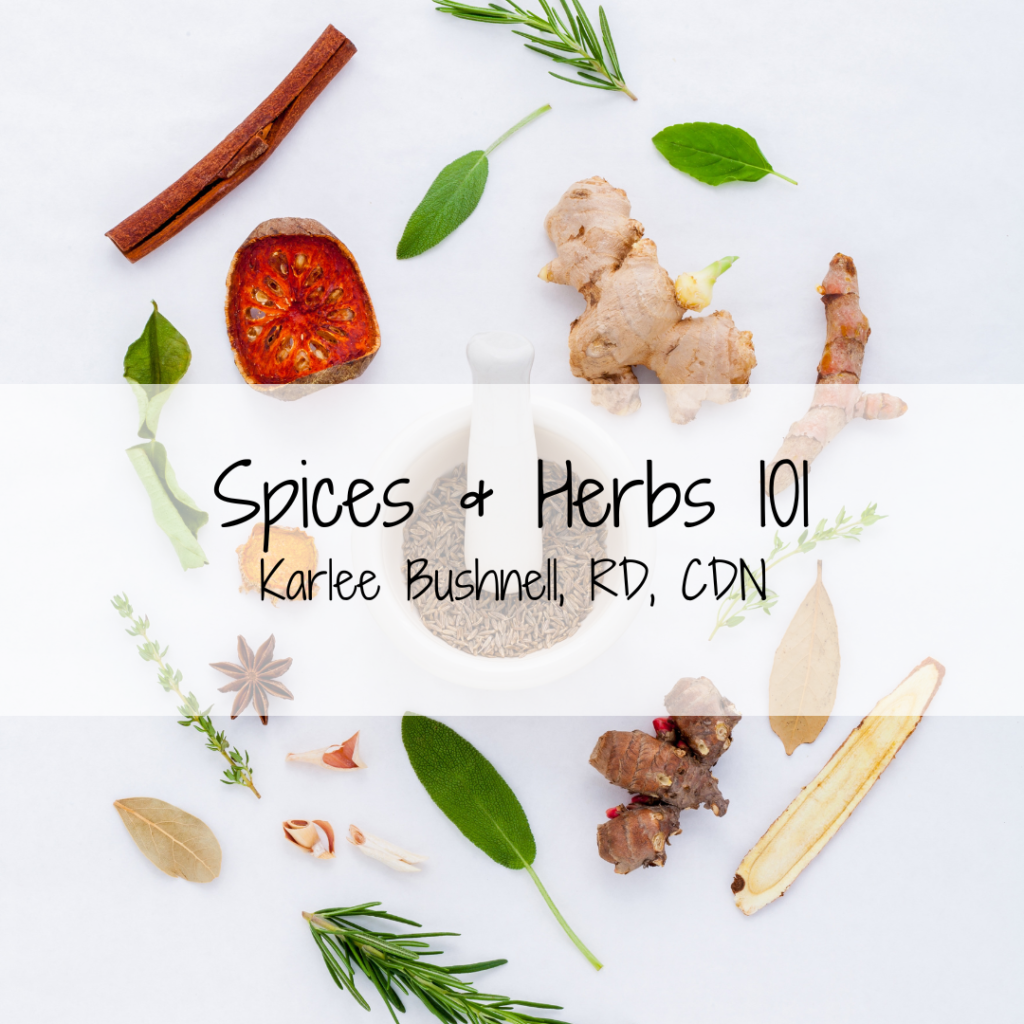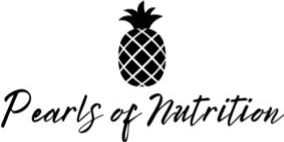
Whether you’re relatively new when it comes to being in the kitchen or you feel fairly confident in your cooking abilities, learning how to use spices and herbs can be really helpful for increasing the satisfaction factor with meals by adding to or enhancing the flavor of foods, aroma, and color, while also adding novelty, and yes, even nutrition in our dietary intake! Historically, spices and herbs have importance and were once thought to signify status and affluence. Black pepper, for example, was once used as currency. Wars were even fought by nations such as Portugal, Spain, and Britain to maintain power and control over these profitable spice trade routes.
So first off, what are they? Both are plant derived substances, which makes it complicated to distinguish between the two; spices can come from all plant parts including, but not limited to: roots, stems, leaves, bark, flowers, and seeds, whereas herbs are commonly thought of as non-woody plants. Spices are typically dried and herbs are usually leafy, but there are some variations to this so it’s not a steadfast method to distinguish the two. Another way to help to differentiate between the two is that spices are often thought of as supporting ingredients to a dish, while herbs are thought of as more of an addition of flavor at the end of a dishes cooking process. Either way, both add flavor to wherever they are incorporated!
You may be thinking, why does my dietitian care about herbs and spices? Because there is nutritional value to spices and herbs as well as providing extra doses of flavor! “Spices and herbs have been in use for centuries both for culinary and medicinal purposes. Spices not only enhance the flavor, aroma, and color of food and beverages, but they can also protect from acute and chronic diseases” (Jiang). According to this referenced research article, certain herbs and spices including chili pepper, cinnamon, black pepper, turmeric, ginger, rosemary, and garlic show evidence of providing nutrition and helping with overall human health.
- When it comes to chili peppers, “the habitual consumption of spicy foods was inversely associated with total and certain cause-specific mortality (cancer, ischemic heart diseases, and respiratory diseases), independent of other risk factors of death”
- Cinnamon has been suggested to decrease fasting plasma glucose (FPG) levels and provide an anti-inflammatory effect on the body
- Clinical trials indicate that ginger can be a helpful therapy for nausea and emesis that is safe and effective for use in pregnancy or when symptoms are induced from chemotherapy
- Rosemary, turmeric, and black pepper have all been shown overall to have antioxidant properties
- Garlic has been shown to have immune-enhancing effects (in other words, toss some extra garlic in that chicken noodle soup when you’re feeling under the weather!)
This is only a small list of the health benefits herbs and spices confer to the body. Below is a list of many common and less commonly used spices and herbs to get your started on your exploration of these flavor and nutrition additives.
| Commonly used spices/herbs: | Less commonly used spices/herbs: |
| -Basil -Bay leaves -Black pepper -Cayenne pepper -Chili powder -Cinnamon -Crushed red pepper -Cumin -Dill -Fennel -Ginger -Mint -Oregano -Paprika -Sage -Salt -Thyme -Turmeric -Vanilla | -Allspice -Annatto -Caraway -Cardamom -Celery seed -Fenugreek -Juniper berries -Lemongrass -Mace -Saffron -Sichuan pepper -Star anise -Tamarind -Tarragon -White pepper |
You may find it easier to begin with the left side of the above chart and start to incorporate more well known and utilized spices and herbs. You’ll likely also find these referred to more regularly in more recipes or cookbooks. However, if you’d like to try some newer spices and spice combinations, this is encouraged too – whatever works best for you and your household!
Here are some tips to begin cooking with spices and herbs:
- If needed, you can grind spices on your own at home with a mortar and pestle or even a coffee grinder. If you’re able to do so, grinding them immediately before adding to your cooking ensures the most flavor intensity.
- You can purchase or make spice blends of commonly used flavors to try out new combinations.
- Here are some commonly used combinations to start with, as well as some ideas on what to use them in:
- Italian seasoning (usually contains oregano, basil, thyme, rosemary, sage). Try this on pastas, pizzas or veggies.
- Cajun seasoning (usually contains black pepper, white pepper, cayenne pepper, onion powder, garlic powder, paprika). Try this on seafood, corn/corn on the cob or when cooking with potatoes.
- Taco seasoning (usually contains salt, paprika, oregano, chili powder, onion powder, garlic powder). Try this for tacos (duh), to add to chili/soup or to make a breakfast dish like a breakfast burrito or huevos rancheros.
- You can find spice blends at your local grocery store, but it can also be worth it to look into any local businesses that specialize in spices. If you live near Pearls of Nutrition in the Rochester area, you can check out Stuart’s Spices or Niblack Foods.
- Ethnic grocery stores also offer unique spices and seasonings that you may not find anywhere else.
- Another wonderful option is Piquant Post. This is a really cool business where you can purchase/gift spice subscription boxes as well as buy individual spices. With each box also comes recipe cards with suggestions for how to use the spice blends, and the website has many further recipes as well. You can navigate on the website with options such as “by region”, to find Caribbean spices, “by profile”, for example, savory spices, or “by ingredient”, such as goes with fish. I was gifted a subscription box and personally love it! It’s been really fun to try new spice blends and follow some of the recipes. This post is not sponsored however the folks over at Piquant Post were kind enough to offer a promo code to those who have made it this far into the blog post! Use code PEARLS for 15% off your purchase*.
- Here are some commonly used combinations to start with, as well as some ideas on what to use them in:
- Heating spices in oil to help release the flavors into the oil, which will then coat the other ingredients, is a process known as “blooming”. Blooming can be helpful to add the most flavor to a dish.
- Growing herbs at home can be done inside or outside – you don’t even need a full blown garden to do so! If you’re interested in gardening, but lack the space, you can check out if there is a community garden somewhere near to you that you could possibly utilize. Gardening, whether it be at home or in a community setting, can be a really fun and educational activity to do with your children if you’re a parent.
- Certain herbs have a more easy-going nature and can be great for beginners. These include: sage, parsley, oregano, mint, thyme, dill, chives, cilantro, basil, and tarragon.
So now that I’ve talked your ear off about spices and herbs, there is one final point to make and it may actually be the most important takeaway message from this post. You cannot “out spice” not eating enough or eating foods that are not truly satisfying to you. If you are a client of mine, it’s likely that I’ve shared this post by Rachael Hartley, RD, LD, Certified Intuitive Eating Counselor, and Author of Gentle Nutrition. The article speaks to a hierarchy of nutrition needs through a non-diet perspective. In this hierarchy, adequacy is the foundation of the pyramid with balance, variety, and individual foods following respectively in rank of their importance. You can have a fully stocked spice rack, but still not be eating enough in terms of energy (AKA calories) or enough variety in your overall food groups. Additionally, if you are not allowing yourself to eat foods that you find satisfying and trying to mask this with a myriad of spices/herbs, you will still likely be lacking the satisfaction factor of foods. If you’re unsure about what is satisfaction and how to find it with eating experiences, I’d recommend this post – “What is Satisfaction?” by my colleague, Kelly Ogden, MS, RD, CDN, which is a wonderful resource! So please know that if you’re not personally ready to implement this kind of thinking into how you best take care of yourself and implement gentle nutrition, that is totally okay.
Here’s to spicing up your meals in the New Year! Happy cooking!
*Discount code PEARLS is valid for 15% off and has the following conditions:
- Store wide discount
- One time use per customer and minimum purchase subtotal of $9 (before discount)
- Promo ends 3/14 @ 11:59 pm PT
Additional resources:
- https://www.fs.usda.gov/wildflowers/ethnobotany/food/spices.shtml
- https://spicetutor.com/what-is-a-spice/
- https://herbsathome.co/the-easiest-herbs-to-grow/
Jiang, T. A. (2019). Health benefits of culinary herbs and spices. Journal of AOAC INTERNATIONAL, 102(2), 395–411. https://doi.org/10.5740/jaoacint.18-0418


